ABBREVIATIONS
Bcl-2
CPT1
DAG
DGAT
FFA
MTT
MUFA
OLA
PAM
PARP
PUFA
RT-PCR
SFA
TAG
INTRODUCTION
METHODS
Materials
Cell culture and FFA treatment
Cell viability assay
Western blot analysis
Reverse transcription-polymerase chain reaction (RT-PCR)
Oil Red O staining
Hoechst staining
Statistical analysis
RESULTS
OLA inhibits PAM-induced apoptotic cell death
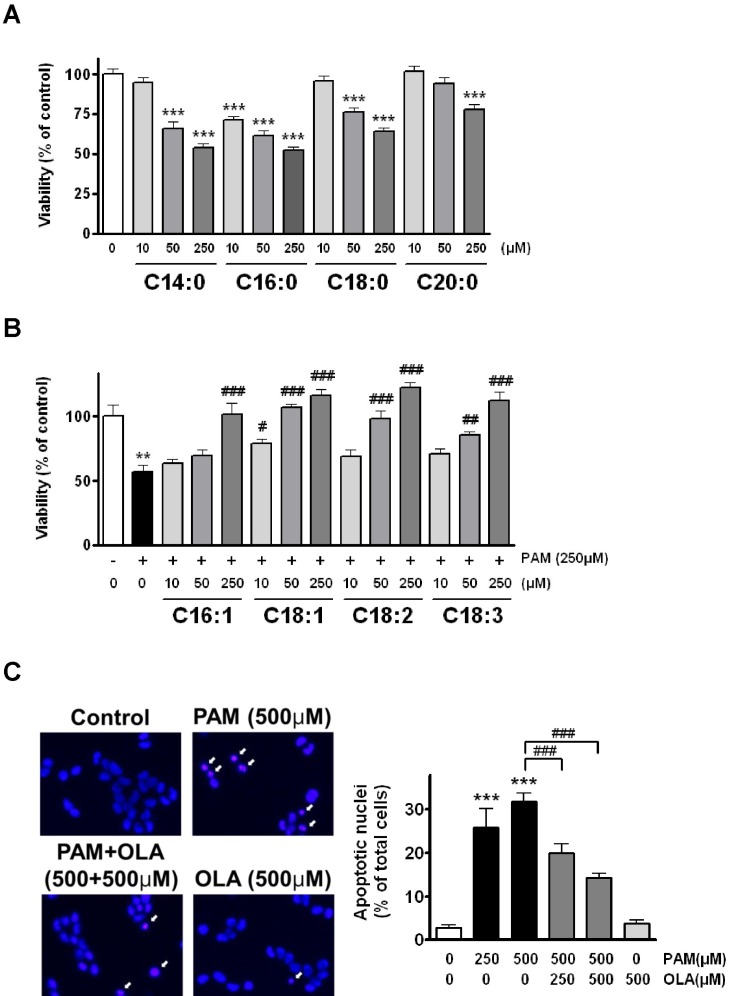 | Fig. 1Co-treatment with oleic acid (OLA) inhibits palmitic acid (PAM)-induced apoptosis in AR42J cells. (A) Different saturated fatty acids induce cell death. Cells were incubated with 10~250 µM of myristic acid (C14:0), palmitic acid (C16:0), stearic acid (C18:0), and arachidic acid (C20:0) for 48 h and then, cell viability was estimated by MTT assay. (B) Different unsaturated fatty acids inhibit PAM-induced cell death. Cells were incubated with 10~250 µM of palmitoleic acid (C16:1), oleic acid (C18:1), linoleic acid (C18:2), and linolenic acid (C18:3) in the presence of 250 µM PAM for 48 h. (C) OLA inhibits PAM-induced apoptosis. Photographs shown on the left are the representative images of Hoechst 33342-stained cells exposed to PAM and OLA either alone or in combination for 48 h. The percentage of apoptotic cells with condensed and segmented chromatin (arrows) is calculated. The results are presented as means±SEM of 4~6 independent experiments. **p<0.01, ***p<0.001, compared to untreated control and #p<0.05, ##p<0.01, ###p<0.001, compared to PAM-treated cells. |
OLA restores PAM-induced changes in levels of apoptosis-related proteins
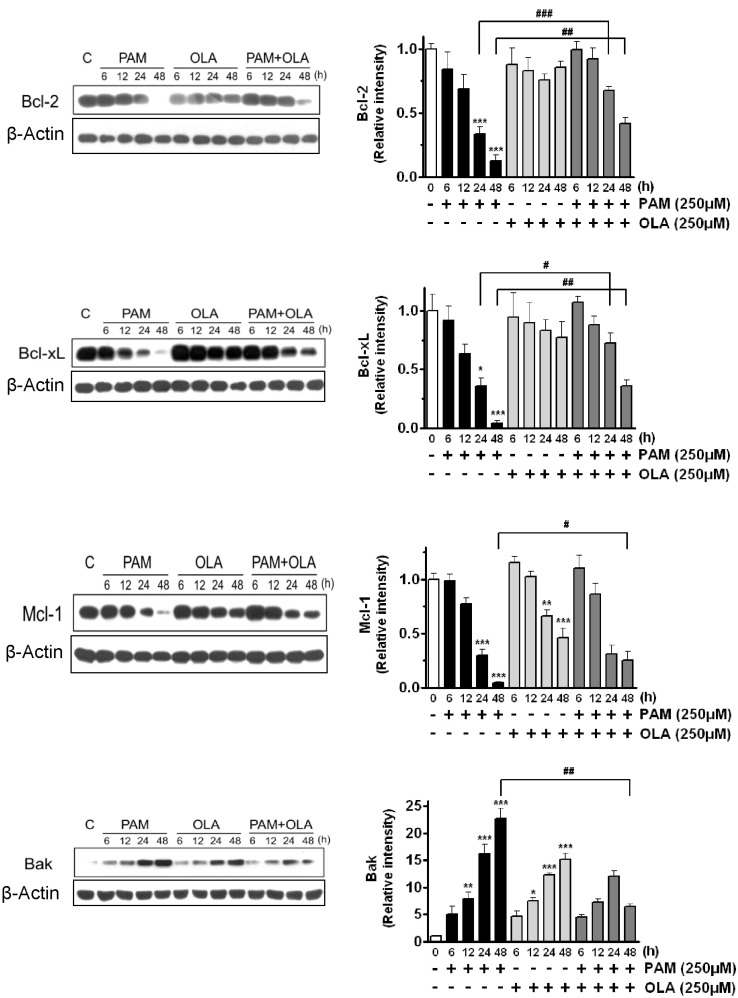 | Fig. 2Effects of oleic acid (OLA) on the levels of anti-apoptotic (Bcl-2, Bcl-xL, Mcl-1) and pro-apoptotic (Bak) Bcl-2 family proteins in palmitic acid (PAM)-treated AR42J cells. Cells were incubated with 250 µM OLA for 6~48 h in the presence or absence of 250 µM PAM. The levels of Bcl-2, Bcl-xL, Mcl-1, and Bak were detected by Western blotting. The results on the right are presented as means±SEM of 3~7 independent experiments. The expression level of each protein was normalized to that of a housekeeping protein, β-actin. *p<0.05, **p<0.01, ***p<0.001, compared to untreated control and #p<0.05, ##p<0.01, ###p<0.001, compared to PAM-treated cells. |
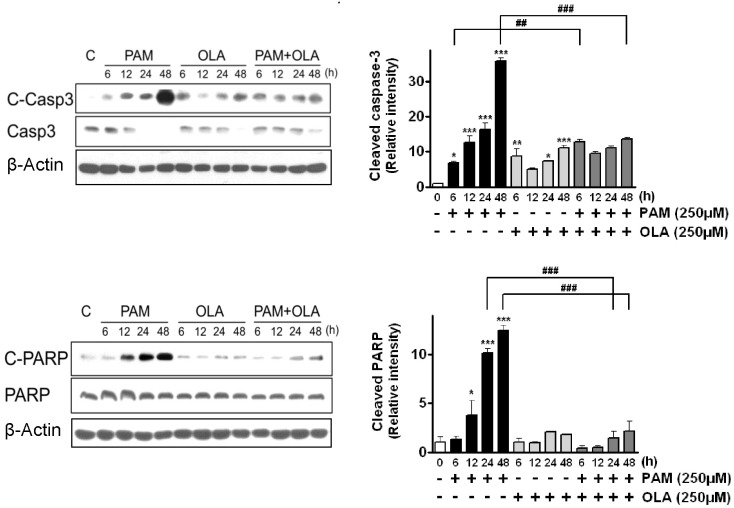 | Fig. 3Effects of oleic acid (OLA) on the levels of cleaved apoptotic proteins (caspase-3, PARP) in palmitic acid (PAM)-treated AR42J cells. Cells were incubated with 250 µM OLA for 6~48 h in the presence or absence of 250 µM PAM. The levels of cleaved caspase-3 (C-Casp3) and cleaved PARP (C-PARP) were detected by Western blotting. The results on the right are presented as means±SEM of 3 independent experiments. The expression level of each protein was normalized to that of a housekeeping protein, β-actin. *p<0.05, ***p<0.001, compared to untreated control and ##p<0.01, ###p<0.001, compared to PAM-treated cells. |
OLA increases the expressions of Dgat2 and Cpt1 genes
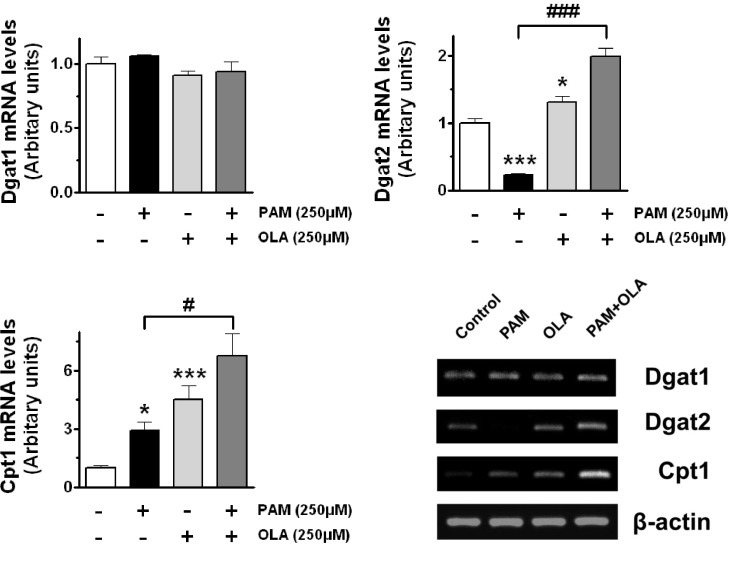 | Fig. 4Oleic acid (OLA) induces up-regulation of Dgat2 and Cpt1 gene expressions in AR42J cells. Cells were incubated with 250 µM OLA for 48 h in the presence or absence of 250 µM palmitic acid (PAM). The mRNA expressions of Dgat1, Dgat2, and Cpt1 genes were determined by RT-PCR. Density of each band was quantified using ImageQuant software. The results are presented as means±SEM of 3~6 independent experiments. The expression level of each gene was normalized to that of a housekeeping gene, β-actin. *p<0.05, ***p<0.001, compared to untreated control and #p<0.05, ###p<0.001, compared to PAM-treated cells. |
OLA increases intracellular TAG accumulation
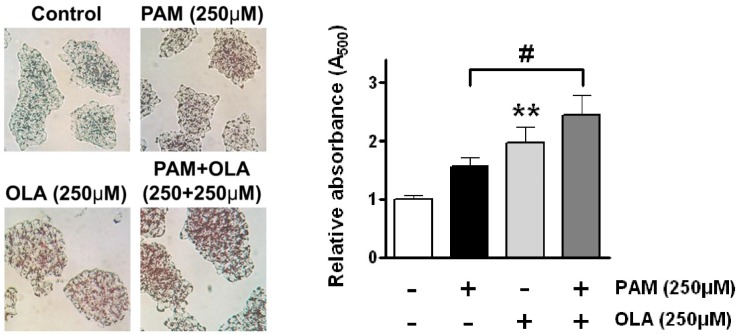 | Fig. 5Oleic acid (OLA) increases the accumulation of intracellular triglyceride (TAG) in AR42J cells. Cells were incubated with 250 µM OLA for 48 h in the presence or absence of 250 µM palmitic acid (PAM). Photographs shown on the left are the representative images of Oil Red O-stained cells exposed to PAM and OLA either alone or in combination for 48 h. After staining cells with Oil Red O, stained dye was extracted with isopropanol and absorbance at 500 nm was measured to estimate the relative content of intracellular TAG. The results on the right are presented as means±SEM of 6 independent experiments. **p<0.01, compared to untreated control and #p<0.05, compared to PAM-treated cells. |




 PDF
PDF ePub
ePub Citation
Citation Print
Print


 XML Download
XML Download